Improving Corrosion Resistance of Zircaloy-4 via High-Current Pulsed Electron Beam Surface Irradiation
Abstract
:1. Introduction
2. Materials and Methods
3. Results
3.1. XRD Analysis
3.2. Microstructural Analysis
3.3. Corrosion Behavior
4. Discussion
5. Conclusions
Author Contributions
Funding
Institutional Review Board Statement
Informed Consent Statement
Data Availability Statement
Conflicts of Interest
References
- Al Mubarak, F.; Rezaee, R.; Wood, D.A. Economic, societal, and environmental impacts of available energy sources: A review. Eng 2024, 5, 1232–1265. [Google Scholar] [CrossRef]
- Dincer, I.; Acar, C. A review on clean energy solutions for better sustainability. Int. J. Energy Res. 2015, 39, 585–606. [Google Scholar] [CrossRef]
- Wu, Y.; Chen, Z.; Wang, Z.; Chen, S.; Ge, D.; Chen, C.; Jia, J.; Li, Y.; Jin, M.; Zhou, T. Nuclear safety in the unexpected second nuclear era. Proc. Natl. Acad. Sci. USA 2019, 116, 17673–17682. [Google Scholar] [CrossRef]
- Diniasi, D.; Golgovici, F.; Marin, A.H.; Negrea, A.D.; Fulger, M.; Demetrescu, I. Long-term corrosion testing of Zy-4 in a LiOH solution under high pressure and temperature conditions. Materials 2021, 14, 4586. [Google Scholar] [CrossRef] [PubMed]
- Ren, L.; Jian, W.; Ge, X.; Wang, H.; Zhang, D.; Chen, X.; Zhang, Q.; Suo, X. Fouling behavior on the zircaloy-4 alloy cladding tube: An experimental and simulation study. Appl. Surf. Sci. 2024, 670, 160724. [Google Scholar] [CrossRef]
- Park, J.Y.; Choi, B.K.; Yoo, S.J.; Jeong, Y.H. Corrosion behavior and oxide properties of Zr–1.1 wt% Nb–0.05 wt% Cu alloy. J. Nucl. Mater. 2006, 359, 59–68. [Google Scholar] [CrossRef]
- Park, J.Y.; Yoo, S.J.; Choi, B.K.; Jeong, Y.H. Oxide microstructures of advanced Zr alloys corroded in 360 C water loop. J. Alloys Compd. 2007, 437, 274–279. [Google Scholar] [CrossRef]
- Yao, M.; Zhou, B.; Li, Q.; Liu, W.; Geng, X.; Lu, Y. A superior corrosion behavior of Zircaloy-4 in lithiated water at 360 °C/18.6 MPa by β-quenching. J. Nucl. Mater. 2008, 374, 197–203. [Google Scholar] [CrossRef]
- Yao, M.; Shen, Y.; Li, Q.; Peng, J.; Zhou, B.; Zhang, J. The effect of final annealing after β-quenching on the corrosion resistance of Zircaloy-4 in lithiated water with 0.04 M LiOH. J. Nucl. Mater. 2013, 435, 63–70. [Google Scholar] [CrossRef]
- Fazi, A.; Stiller, K.; Andrén, H.O.; Thuvander, M. Cold sprayed Cr-coating on Optimized ZIRLO™ claddings: The Cr/Zr interface and its microstructural and chemical evolution after autoclave corrosion testing. J. Nucl. Mater. 2022, 560, 153505. [Google Scholar] [CrossRef]
- Alat, E.; Motta, A.T.; Comstock, R.J.; Partezana, J.M.; Wolfe, D.E. Multilayer (TiN, TiAlN) ceramic coatings for nuclear fuel cladding. J. Nucl. Mater. 2016, 478, 236–244. [Google Scholar] [CrossRef]
- Zhao, Y.; Liu, J. The effect of laser surface treatment on the nodular corrosion of Zircaloy-4. Rare. Metal. Mat. Eng 1996, 25, 44–46. [Google Scholar]
- Peng, D.; Bai, X.; Pan, F.; Sun, H.; Chen, B. Influence of aluminum ions implanted on oxidation behavior of ZIRLO alloy at 500 C. Vacuum 2006, 80, 530–536. [Google Scholar] [CrossRef]
- Liu, Y.; Zu, X.; Qiu, S.; Li, C.; Ma, W.; Huang, X. Surface characteristics and oxidation behavior of nitrogen ion-implanted Zr–Sn–Nb alloy. Surf. Coat. Technol. 2006, 200, 5631–5635. [Google Scholar] [CrossRef]
- Ryabchikov, A.; Kashkarov, E.; Shevelev, A.; Syrtanov, M. High-intensity chromium ion implantation into Zr-1Nb alloy. Surf. Coat. Technol. 2020, 383, 125272. [Google Scholar] [CrossRef]
- Zhang, Y.; Weber, W.J. Ion irradiation and modification: The role of coupled electronic and nuclear energy dissipation and subsequent nonequilibrium processes in materials. Appl. Phys. Rev. 2020, 7, 041307. [Google Scholar] [CrossRef]
- Grosdidier, T.; Zou, J.; Bolle, B.; Hao, S.; Dong, C. Grain refinement, hardening and metastable phase formation by high current pulsed electron beam (HCPEB) treatment under heating and melting modes. J. Alloys Compd. 2010, 504, S508–S511. [Google Scholar] [CrossRef]
- Meisner, S.; Vlasov, I.; Yakovlev, E.; Panin, S.; Meisner, L.; D’yachenko, F. Impact of electron beam surface modification on deformation behavior and fracture properties of TiNi shape memory alloy. Mater. Sci. Eng. A 2019, 740, 381–389. [Google Scholar] [CrossRef]
- Ozur, G.; Proskurovsky, D.; Karlik, K. A wide-aperture, low-energy, and high-current electron beam source with a plasma anode based on a reflective discharge. Instrum. Exp. Tech. 2005, 48, 753–760. [Google Scholar] [CrossRef]
- Dong, C.; Wu, A.M.; Hao, S.Z.; Zou, J.; Liu, Z.; Zhong, P.; Zhang, A.; Xu, T.; Chen, J.; Xu, J. Surface treatment by high current pulsed electron beam. Surf. Coat. Technol. 2003, 163, 620–624. [Google Scholar] [CrossRef]
- Proskurovsky, D.; Rotshtein, V.; Ozur, G.; Ivanov, Y.F.; Markov, A. Physical foundations for surface treatment of materials with low energy, high current electron beams. Surf. Coat. Technol. 2000, 125, 49–56. [Google Scholar] [CrossRef]
- Zou, J.; Grosdidier, T.; Zhang, K.; Dong, C. Mechanisms of nanostructure and metastable phase formations in the surface melted layers of a HCPEB-treated D2 steel. Acta Mater. 2006, 54, 5409–5419. [Google Scholar] [CrossRef]
- Liu, Y.; Zhang, K.; Zou, J.; Liu, D.; Zhang, T. Effect of the high current pulsed electron beam treatment on the surface microstructure and corrosion resistance of a Mg-4Sm alloy. J. Alloys Compd. 2018, 741, 65–75. [Google Scholar] [CrossRef]
- Song, L.; Zhang, K.; Zou, J.; Yan, P. Surface modifications of a hyperperitectic Zn-10 wt% Cu alloy by pulsed electron beam treatment. Surf. Coat. Technol. 2020, 388, 125530. [Google Scholar] [CrossRef]
- Wu, P.P.; Deng, K.K.; Nie, K.B.; Zhang, Z.Z. Corrosion resistance of AZ91 Mg alloy modified by high-current pulsed electron beam. Acta Metall. Sin. 2019, 32, 218–226. [Google Scholar] [CrossRef]
- Cai, J.; Li, X.; Lyu, P.; Guan, Q.; Lu, J.; Xue, W. Hot corrosion behavior of NiCoCrAlYSi laser cladding coating modified using high-current pulsed electron beam in different corrosive salt environments. Mater. Charact. 2024, 208, 113565. [Google Scholar] [CrossRef]
- Wang, M.; Du, L.; Xu, Y.; Zhang, X.; Qi, P.; Xu, P.; Peng, W. Surface microstructure evolution mechanism of WC-Co hard alloy treated by high current pulsed electron beam. Vacuum 2022, 202, 111139. [Google Scholar] [CrossRef]
- Lyu, P.; Peng, T.; Miao, Y.; Liu, Z.; Gao, Q.; Zhang, C.; Jin, Y.; Guan, Q.; Cai, J. Microstructure and properties of CoCrFeNiMo0. 2 high-entropy alloy enhanced by high-current pulsed electron beam. Surf. Coat. Technol. 2021, 410, 126911. [Google Scholar] [CrossRef]
- Zhang, L.; Peng, C.-T.; Shi, J.; Jin, Y.; Lu, R. Influence of high current pulsed electron beam on microstructure and properties of Ni–W alloy coatings. J. Alloys Compd. 2020, 828, 154460. [Google Scholar] [CrossRef]
- Duan, R.; Tian, M.; Li, Y.; Bai, P.; Zhao, Z.; Wang, J.; Wei, S. Hot corrosion behavior of NiCoCrAlY laser cladding coating on 17-4PH stainless steel before and after high-current pulsed electron beam irradiation. J. Vac. Sci. Technol. A 2023, 41, 053103. [Google Scholar] [CrossRef]
- Lv, P.; Sun, X.; Cai, J.; Zhang, C.; Liu, X.; Guan, Q. Microstructure and high temperature oxidation resistance of nickel based alloy GH4169 irradiated by high current pulsed electron beam. Surf. Coat. Technol. 2017, 309, 401–409. [Google Scholar] [CrossRef]
- Samih, Y.; Marcos, G.; Stein, N.; Allain, N.; Fleury, E.; Dong, C.; Grosdidier, T. Microstructure modifications and associated hardness and corrosion improvements in the AISI 420 martensitic stainless steel treated by high current pulsed electron beam (HCPEB). Surf. Coat. Technol. 2014, 259, 737–745. [Google Scholar] [CrossRef]
- Zhang, Z.; Yang, S.; Lv, P.; Li, Y.; Wang, X.; Hou, X.; Guan, Q. The microstructures and corrosion properties of polycrystalline copper induced by high-current pulsed electron beam. Appl. Surf. Sci. 2014, 294, 9–14. [Google Scholar] [CrossRef]
- Grosdidier, T.; Zou, J.; Stein, N.; Boulanger, C.; Hao, S.; Dong, C. Texture modification, grain refinement and improved hardness/corrosion balance of a FeAl alloy by pulsed electron beam surface treatment in the “heating mode”. Scr. Mater. 2008, 58, 1058–1061. [Google Scholar] [CrossRef]
- Yang, S.; Guo, Z.; Zhang, M.; Guan, Q.; Jin, Y.; Liu, Y. Effect of high current pulsed electron beam surface irradiation on the microstructure and electrochemical behavior of zircaloy-4. Nucl. Instrum. Methods Phys. Res. Sect. B 2018, 434, 81–87. [Google Scholar] [CrossRef]
- Chai, L.; Chen, B.; Wang, S.; Zhang, Z.; Murty, K.L. Microstructural, textural and hardness evolution of commercially pure Zr surface-treated by high current pulsed electron beam. Appl. Surf. Sci. 2016, 390, 430–434. [Google Scholar] [CrossRef]
- Zhang, X.; Hao, S.; Li, X.; Dong, C.; Grosdidier, T. Surface modification of pure titanium by pulsed electron beam. Appl. Surf. Sci. 2011, 257, 5899–5902. [Google Scholar] [CrossRef]
- Zhao, W.; Liu, Y.; Jiang, H.; Peng, Q. Effect of heat treatment and Nb and H contents on the phase transformation of N18 and N36 zirconium alloys. J. Alloys Compd. 2008, 462, 103–108. [Google Scholar] [CrossRef]
- Zhang, X.; Zou, J.; Weber, S.; Hao, S.; Dong, C.; Grosdidier, T. Microstructure and property modifications in a near α Ti alloy induced by pulsed electron beam surface treatment. Surf. Coat. Technol. 2011, 206, 295–304. [Google Scholar] [CrossRef]
- Cai, J.; Lv, P.; Guan, Q.; Xu, X.; Lu, J.; Wang, Z.; Han, Z. Thermal cycling behavior of thermal barrier coatings with MCrAlY bond coat irradiated by high-current pulsed electron beam. ACS Appl. Mater. Interfaces 2016, 8, 32541–32556. [Google Scholar] [CrossRef]
- Hao, S.; Gao, B.; Wu, A.; Zou, J.; Qin, Y.; Dong, C.; An, J.; Guan, Q. Surface modification of steels and magnesium alloy by high current pulsed electron beam. Nucl. Instrum. Methods Phys. Res. Sect. B 2005, 240, 646–652. [Google Scholar] [CrossRef]
- Xu, F.; Tang, G.; Guo, G.; Ma, X.; Ozur, G. Influence of irradiation number of high current pulsed electron beam on the structure and properties of M50 steel. Nucl. Instrum. Methods Phys. Res. Sect. B 2010, 268, 2395–2399. [Google Scholar] [CrossRef]
- Kajiwara, S.; Ohno, S.; Honma, K. Martensitic transformations in ultra-fine particles of metals and alloys. Philos. Mag. A 1991, 63, 625–644. [Google Scholar] [CrossRef]
- Grosdidier, T.; Combres, Y.; Gautier, E.; Philippe, M.-J. Effect of microstructure variations on the formation of deformation-induced martensite and associated tensile properties in a β metastable Ti alloy. Metall. Mater. Trans. A 2000, 31, 1095–1106. [Google Scholar] [CrossRef]
- Meng, Q.; Rong, Y.; Hsu, T. Nucleation barrier for phase transformations in nanosized crystals. Phys. Rev. B 2002, 65, 174118. [Google Scholar] [CrossRef]
- Zhang, K.; Yang, D.; Zou, J.; Grosdidier, T.; Dong, C. Improved in vitro corrosion resistance of a NiTi alloy by high current pulsed electron beam treatment. Surf. Coat. Technol. 2006, 201, 3096–3102. [Google Scholar] [CrossRef]
- Xie, X.; Zhang, J.; Yao, M.; Zhou, B.; Peng, J.; Liang, X. Oxide microstructural evolution of Zr–0.7 Sn–0.35 Nb–0.3 Fe alloys containing Ge corroded in lithiated water. J. Nucl. Mater. 2014, 451, 255–263. [Google Scholar] [CrossRef]
- Evans, H. Stress effects in high temperature oxidation of metals. Int. Mater. Rev. 1995, 40, 1–40. [Google Scholar] [CrossRef]
- Xie, S.; Zhou, B.; Liang, X.; Liu, W.; Li, H.; Li, Q.; Yao, M.; Zhang, J. A novel mechanism for nodular corrosion of Zircaloy-4 corroded in 773 K superheated steam. Corros. Sci. 2017, 126, 44–54. [Google Scholar] [CrossRef]
- Pecheur, D.; Lefebvre, F.; Motta, A.T.; Lemaignan, C.; Wadier, J. Precipitate evolution in the Zircaloy-4 oxide layer. J. Nucl. Mater. 1992, 189, 318–332. [Google Scholar] [CrossRef]
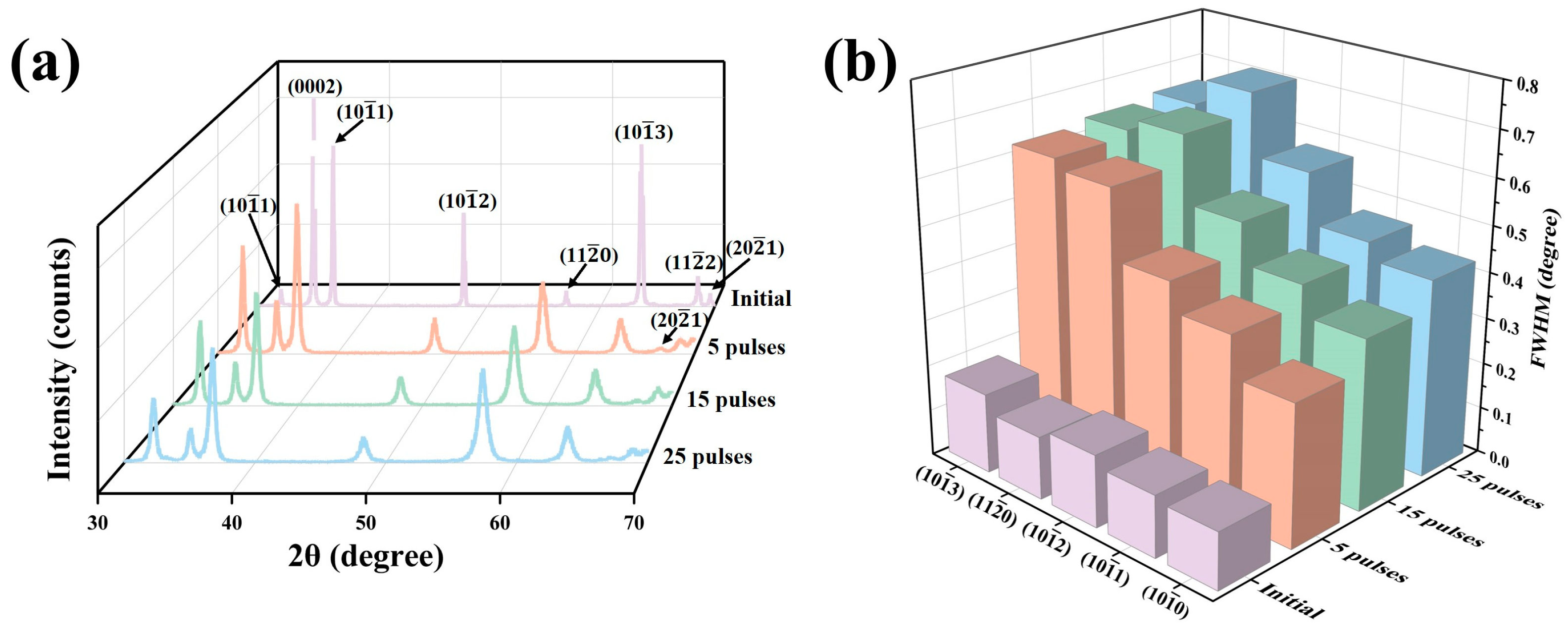
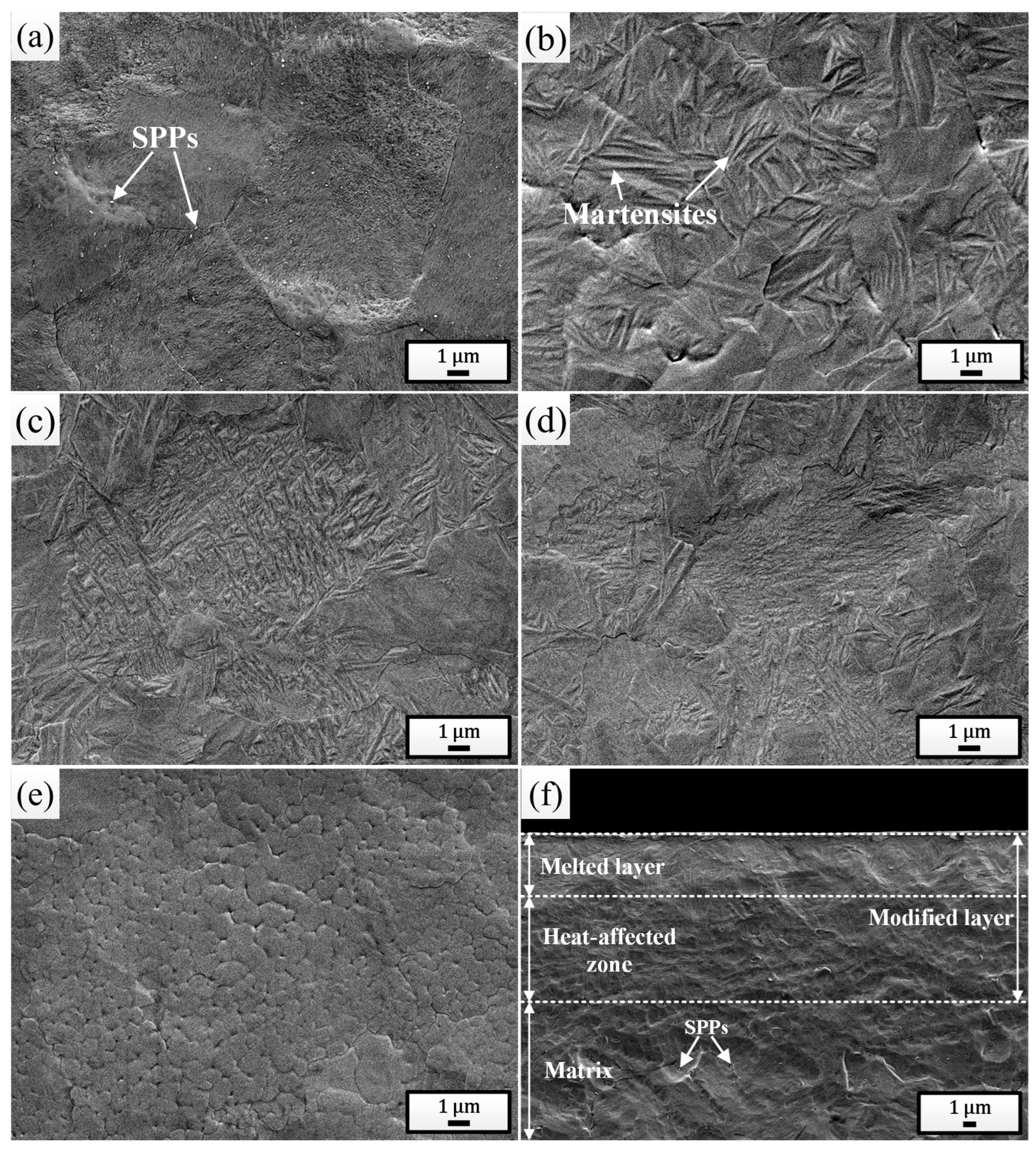
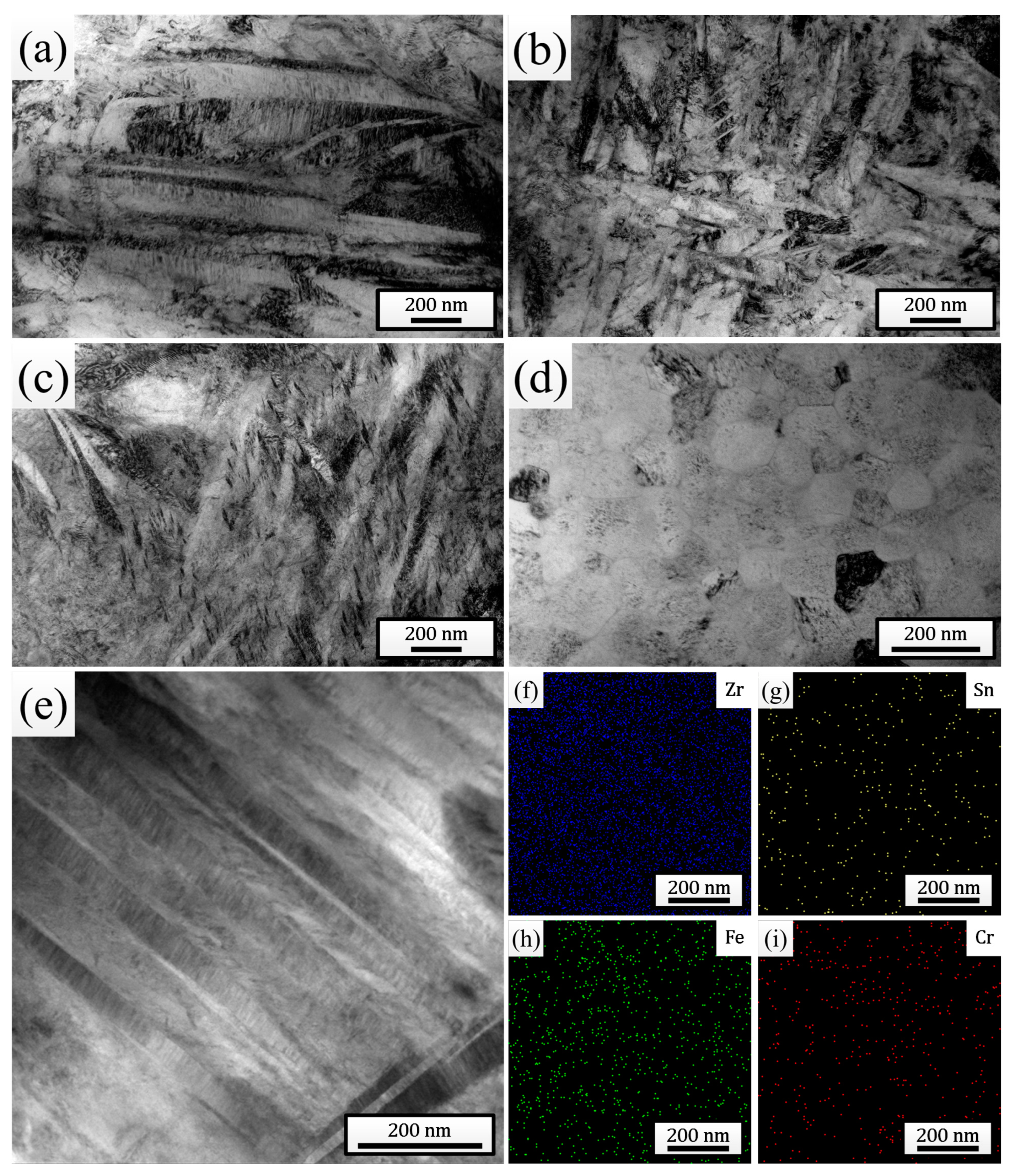
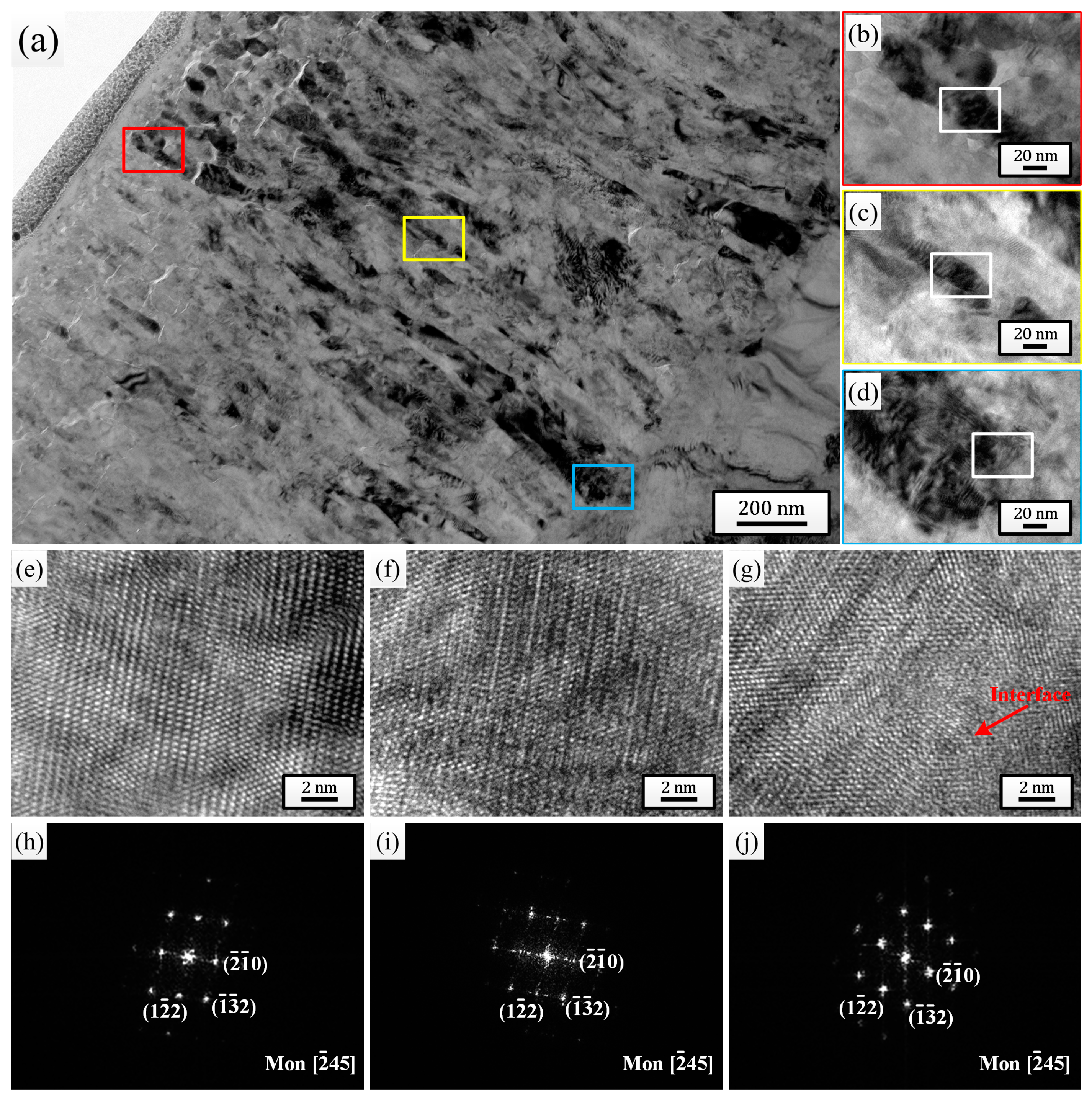
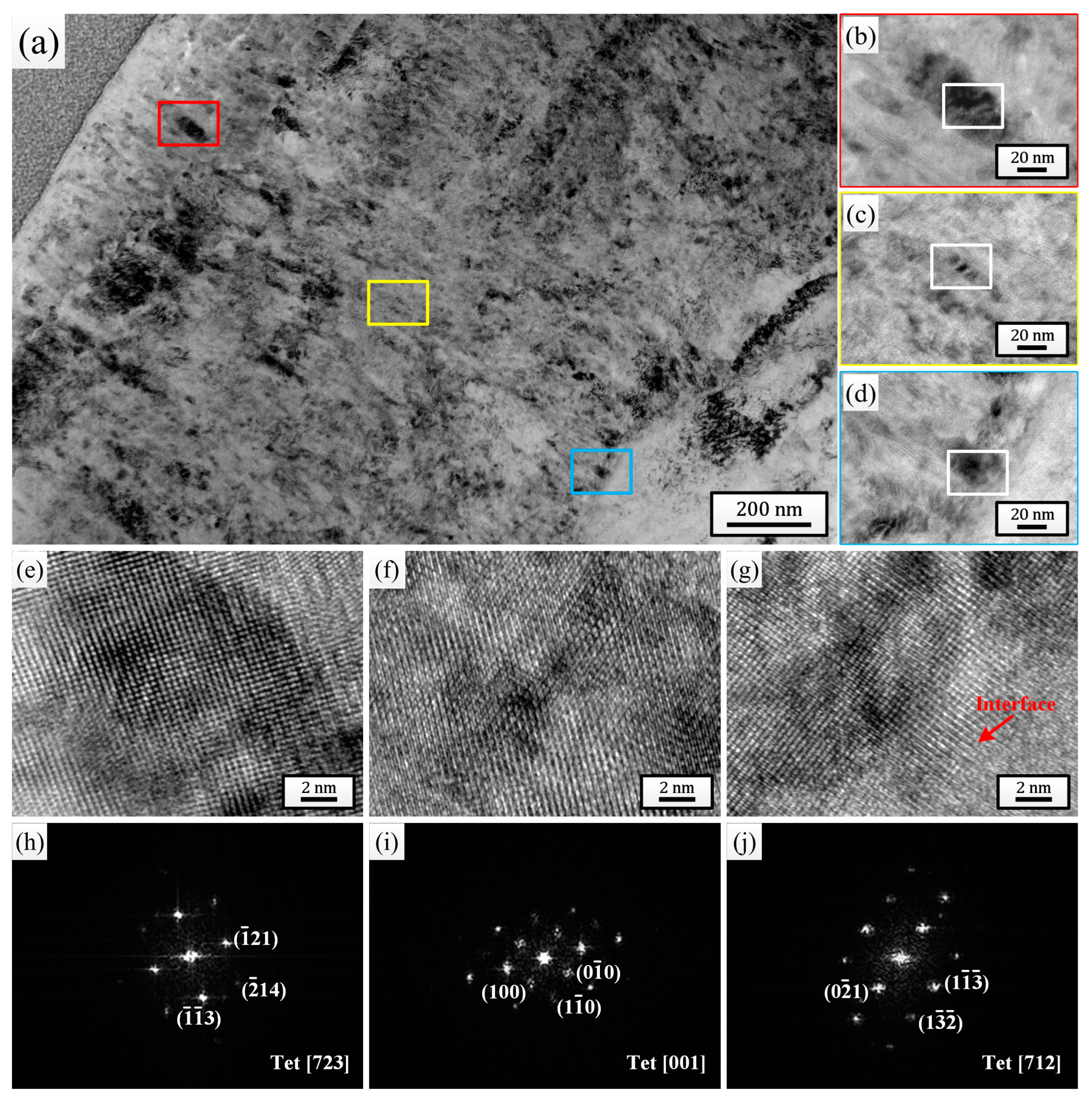
| Accelerating Voltage | Pulse Duration | Energy Density | Vacuum | Number of Irradiation Times |
|---|---|---|---|---|
| 27 kV | 1.5 μs | 4 J/cm2 | 5 × 10−3 Pa | 5, 15, 25 |
Disclaimer/Publisher’s Note: The statements, opinions and data contained in all publications are solely those of the individual author(s) and contributor(s) and not of MDPI and/or the editor(s). MDPI and/or the editor(s) disclaim responsibility for any injury to people or property resulting from any ideas, methods, instructions or products referred to in the content. |
© 2024 by the authors. Licensee MDPI, Basel, Switzerland. This article is an open access article distributed under the terms and conditions of the Creative Commons Attribution (CC BY) license (https://creativecommons.org/licenses/by/4.0/).
Share and Cite
Yang, S.; Yao, H.; Hu, Z.; Chen, T. Improving Corrosion Resistance of Zircaloy-4 via High-Current Pulsed Electron Beam Surface Irradiation. Materials 2025, 18, 76. https://doi.org/10.3390/ma18010076
Yang S, Yao H, Hu Z, Chen T. Improving Corrosion Resistance of Zircaloy-4 via High-Current Pulsed Electron Beam Surface Irradiation. Materials. 2025; 18(1):76. https://doi.org/10.3390/ma18010076
Chicago/Turabian StyleYang, Shen, Heran Yao, Zhiyong Hu, and Tao Chen. 2025. "Improving Corrosion Resistance of Zircaloy-4 via High-Current Pulsed Electron Beam Surface Irradiation" Materials 18, no. 1: 76. https://doi.org/10.3390/ma18010076
APA StyleYang, S., Yao, H., Hu, Z., & Chen, T. (2025). Improving Corrosion Resistance of Zircaloy-4 via High-Current Pulsed Electron Beam Surface Irradiation. Materials, 18(1), 76. https://doi.org/10.3390/ma18010076






